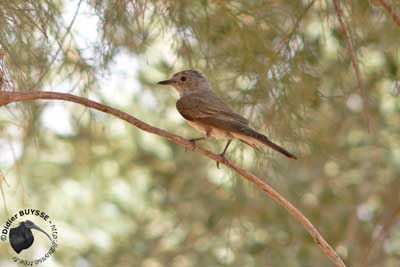
Fr: Gobemouche gris
All : Grauschnäpper
Esp : Papamoscas Gris
Ital: Pigliamosche europeo
Nd: Grauwe Vliegenvanger
Sd: Grå flugsnappare
Photographers:
Didier Buysse
Vision d’Oiseaux
Steve Garvie
RAINBIRDER Photo galleries
Paul Guillet
Photos d'Oiseaux
Jean Michel Peers
JMPN PHOTOGRAPHIE
Nicole Bouglouan
PHOTOGRAPHIC RAMBLE
Text by Nicole Bouglouan
Sources:
HANDBOOK OF THE BIRDS OF THE WORLD Vol 11 by Josep del Hoyo, Andrew Elliott and David Christie - Lynx Edicions - ISBN: 849655306X
THE HANDBOOK OF BIRD IDENTIFICATION FOR EUROPE AND THE WESTERN PALEARCTIC by Mark Beaman, Steve Madge - C.Helm - ISBN: 0713639601
THE COMPLETE BOOK OF BRITISH BIRDS – Written by “Royal Society for the Protection of Birds” experts - Préface de Magnus Magnusson - Michael Cady- Rob Hume Editors - ISBN: 0749509112
ENCYCLOPEDIE DES OISEAUX DE FRANCE ET D’EUROPE – de Peter Hayman et Rob Hume - Flammarion – ISBN : 2082009920
BirdLife International (BirdLife International)
Birds of Britain - The Web Magazine for Birdwatchers
Wikipedia, the free encyclopaedia
Spotted Flycatcher
Muscicapa striata
Passeriforme Order – Muscicapidae Family
BIOMETRICS:
L : 13-15 cm
Poids : 11-22 gr
DESCRIPTION:
The Spotted Flycatcher is an elegant songbird, showing slim upright profile when perched in prominent place before to sally for catching insects.

Adult has grey-brown upperparts with darker upperwing. Scapulars, median and lesser upperwing-coverts are finely edged buffy-white.
On the tail, the uppertail-coverts show pale grey edges whereas the rectrices are dark brown with narrow whitish tips.
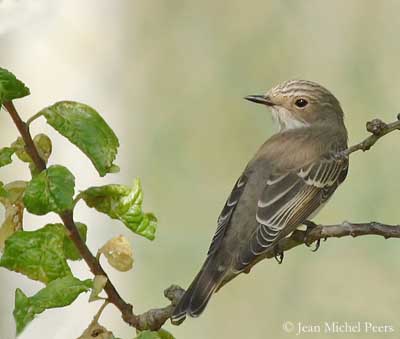
The underparts are dull white with pale grey-buff tinge on breast, flanks and thighs. Chin and throat sides, breast and upper flanks are finely streaked grey-brown. The underwing-coverts are grey-brown with broad pale buff edges.
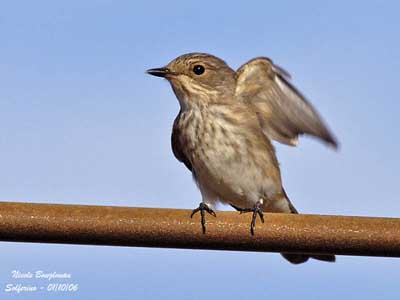
The head is grey-brown streaked blackish-brown with paler forehead and forecrown. Lores are whitish.
The bill is blackish-brown, with paler base of lower mandible. Eyes are dark brown. Legs and feet are blackish-brown.
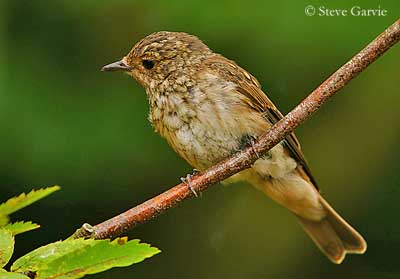
Both sexes are similar.
The juvenile resembles adults, but it has scaled effect on the upperparts and spotted underparts, mainly on the breast.
We ind several subspecies which differ in size, greyer or browner appearance, more or less streaked breast, longer or shorter wings and tail.
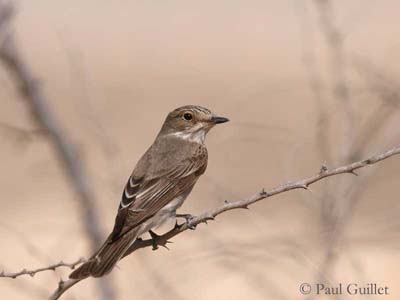
VOICE: SOUNDS BY XENO-CANTO
The Spotted Flycatcher’s calls include thin “zeee” and sharp, harsh “chirrt”. The alarm call is “zee-zucc” or “tek-tek”, or a rattling “ch-r-r-r-r-rer”.
The song is a weak series of short, squeaky notes with high-pitched sounds interspersed with trills “sip-sip-sree… sree-tisree-sip…” or a quick “sip-sip-see-sitti-se-see”.
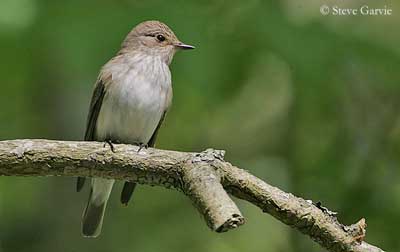
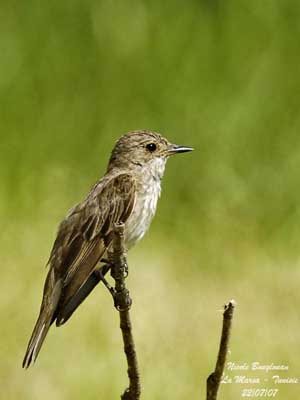
HABITAT:
The Spotted Flycatcher needs prominent perches providing a good open view. It frequents the open woodlands and on the breeding grounds, it favours the well-spaced mature trees, making this bird adapted to avenues, parks and gardens with trees in towns. It also can be seen at forest edges, in clearings and in trees along the streams.
In Africa, on the wintering grounds, they are found in similar habitats, in all kinds of woodlands with different trees’ species.
The Spotted Flycatcher breeds from sea-level to 2000 metres of elevation, and in Africa, it can be seen up to 3000 metres.
RANGE:
The Spotted Flycatcher is an Old World species. It breeds in most parts of Europe and Western Asia.
This is a migratory species, wintering in sub-Saharan Africa and SW Asia.
BEHAVIOUR:
The Spotted Flycatcher feeds primarily on flying insects of several species, and also spiders, harvestmen, snails and earthworms, and some small fruits and berries.
It hunts by performing sallies from perch, at 1-2 metres above the ground. It catches the prey while flying, and returns to the perch to eat the insect.
It hawks the preys by moving continuously from perch to perch. Some preys are gleaned from the vegetation and others are taken on the ground. It may hover in front of fruiting bushes to pluck small fruits and berries. It removes the stings of wasps and bees by beating them against a hard surface.
The Spotted Flycatcher is usually alone or in pairs, but also in family groups. During the migrations, they are seen in large flocks.
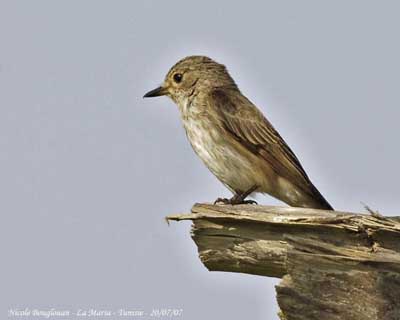
They are territorial birds and nest solitary. They usually are monogamous and the pair-bonds are maintained for the second brood. They defend the nest-site and their favourite perches. They often flick the wings and jerk the tail in many situations.
During the pair formation, the male sings strongly and displays at suitable nest-site. It crouches with ruffled crown and throat feathers, it bows, and moves the head up and down or to and fro, and it flicks the tail.
FLIGHT:
The Spotted Flycatcher is a long-distance migrant. It has long and pointed wings. It hunts on the wing in acrobatic way and is very agile in flight.
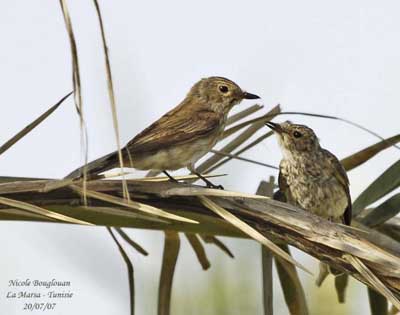
REPRODUCTION:
The breeding season in Europe occurs between mid-May and mid-August.
The nest is built mainly by the female, but sometimes, the male may help her. This is a bulky cup made with fine twigs, rootlets, dead leaves, moss and dry grass. The interior is lined with softer material such as hair and feathers.
The nest is often placed in hole in tree or on flat branch.
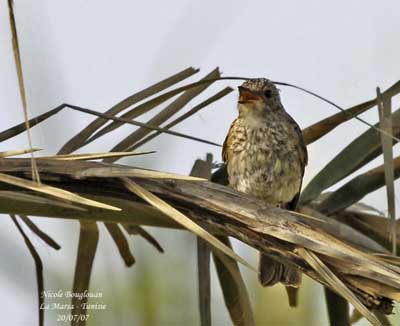
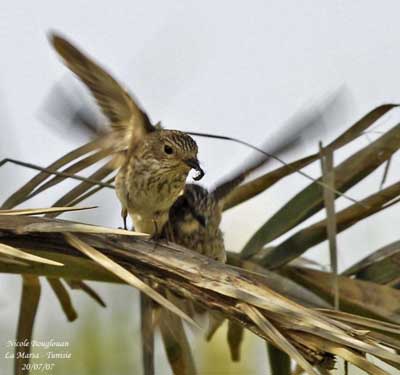
The female lays 2-7 eggs at daily intervals. She incubates during 10-17 days, usually 13 days. The chicks are fed by both parents, and leave the nest about 12-17 days after hatching. Parents feed them during a period varying between 12 and 32 days.
The female will lay a new brood again if the first clutch is lost. This species produces two broods per season.
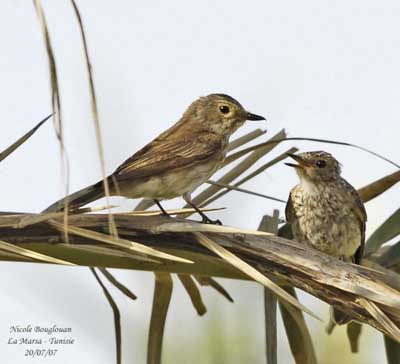
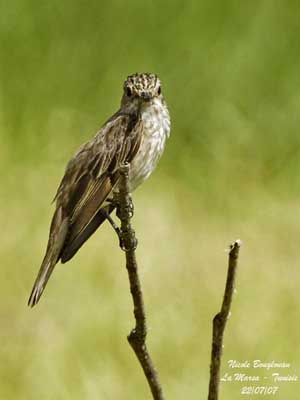
DIET:
The Spotted Flycatcher feeds on several insects’ species such as diptera, hymenoptera, lepidoptera, orthoptera, hemiptera and coleopteran. It also takes spiders, earthworms and snails, and small fruits and berries.
It performs sallies from a prominent perch and catches the prey while flying. Then, it returns to the perch to eat it.
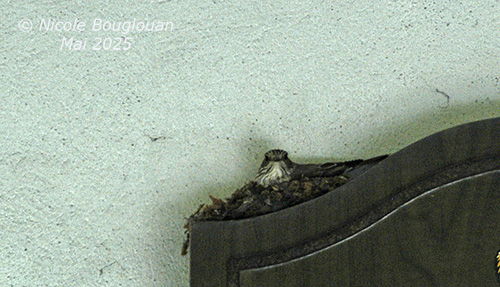
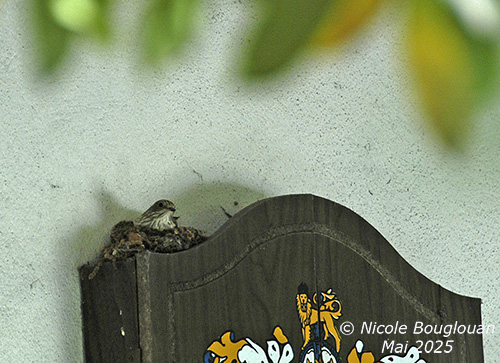
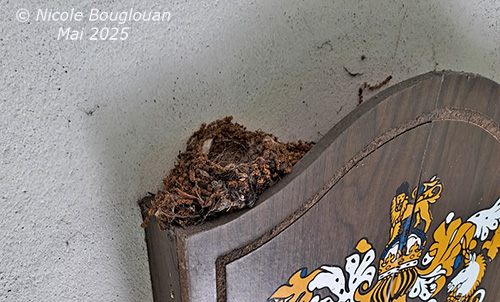
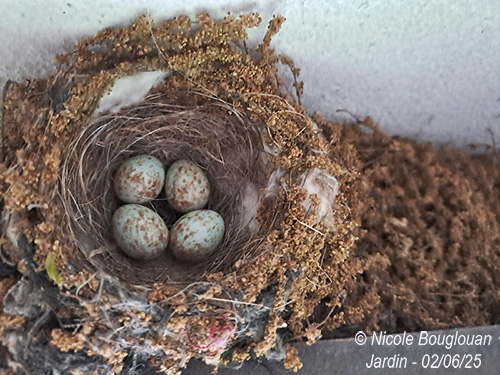
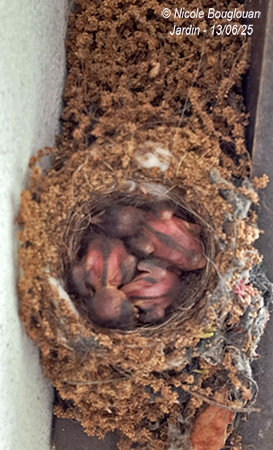
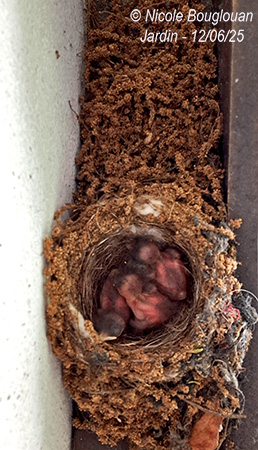
Observation Report: Reproduction of the Spotted Flycatcher in the garden
Chicks observed 24 hours apart
June 12 on the left and June 13 on the right